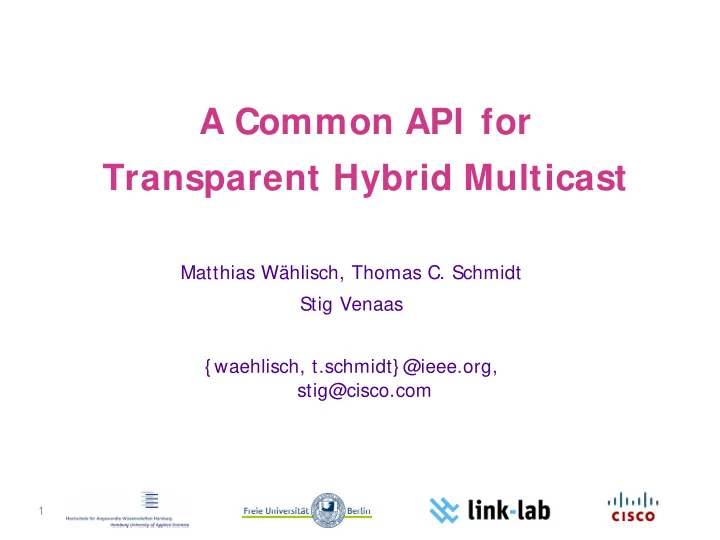

A Common API for Transparent Hybrid Multicast Matthias Wählisch, Thomas C. Schmidt Stig Venaas { waehlisch, t.schmidt} @ieee.org, stig@cisco.com 1
Problem Statement Group communication is implemented on different layers o and is based on different technologies This results in several forwarding paths and varying - group addresses (namespaces) Objectives: 1. Enable any application programmer to implement independent of underlying delivery mechanisms 2. Make applications efficient, but robust w.r.t. deployment aspects 2
Requirements o Design of a common group communication API o Flexible namespace support in group addressing - Separate routing and addressing scheme from application design o Mapping between different namespaces o Gateway function to forward multicast data between different technologies o Consistent view on multicast states at a single host 3
Reference Scenarios +-------+ +-------+ | Member| | Member| | Foo | | G | +-------+ +-------+ o Domains running \ / *** *** *** *** same technology * ** ** ** * * * but remaining * MCast Tec A * * * isolated * ** ** ** * *** *** *** *** +-------+ +-------+ | o Domains running | Member| | Member| +-------+ | G | | Foo | | IMG | distinct technologies +-------+ +-------+ +-------+ | | | but hosts are *** *** *** *** *** *** *** *** * ** ** ** * * ** ** ** * members of the * * +-------+ * * * MCast Tec A * --| IMG |-- * MCast Tec B * +-------+ same group * * +-------+ * * - | Member| * ** ** ** * * ** ** ** * | G | *** *** *** *** *** *** *** *** +-------+ 4
Overview *-------* *-------* o Extended multicast functions | App 1 | | App 2 | implemented by a middleware *-------* *-------* | | o Middleware *---------------------* | Middleware | - Provides extended API *---------------------* | | - Bridges data between technol. *---------* | | Overlay | | o General procedure *---------* | 1. App. subscribes/leaves/sends | | | | to a logical group ID *---------------------* | Underlay | 2. Middleware maps logical ID to *---------------------* technical group ID 3. Technical ID is allocated or revised if already in use 5
Namespace Issue (or Challenge …) Scenario: Two (or more) different addresses in different namespaces may belong to (1) the same multicast channel (same technical ID) (2) different multicast channels (different technical IDs) Can be solved based on a invertible mapping o Does not hold in general (cardinality of namespaces) - Example: Mapping IPv6 to IPv4 - 6
Assumptions o Assumptions: - All group members subscribe to the same logical group ID from the same namespace - Domain composition and node attachment to specific technology remain unchanged during multicast session o Problem: Traditional applications - Inter-domain multicast gateway bridges data 7
Send/Receive Calls – Required for Endhosts and Gateways o Mode: Defines multicast technique o init(in Namespace n) Pre-initializes the namespace for a group - o join(in Address a, in Mode m) Subscribes to a group - o leave(in Address a, in Mode m) o send(in Address a, in Mode m) 8
Service Calls – Required for Gateways o groupSet(out Address[] g, in Mode m) - Returns all registered multicast groups o neighborSet(out Address[] a, in Mode m) - Returns the set of multicast neighbors o designatedHost(out Bool b, in Address a) - Checks if the host is designated router o updateListener(out Address g, in Mode m) - Upcall informs about change of listener states o updateSender(out Address g, in Mode m) - Upcall informs about change of source states 9
Open Issues o Mapping service (e.g., DHT) o Encoding of routing addresses and technologies at the mapping service o ASM service via SSM delivery o Any scenarios not covered by the draft/API? 10
Conclusion o API enables technology-agnostic programming of group-oriented applications o API can be used to implement hybrid multicast gateway - Draft describes interaction with IP-layer multicast routing protocols (PIM-SM etc.) 11
Recommend
More recommend